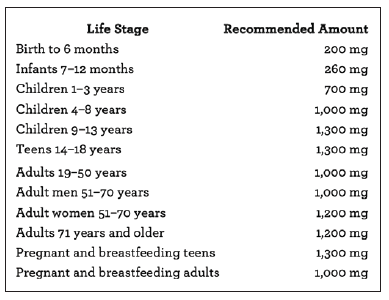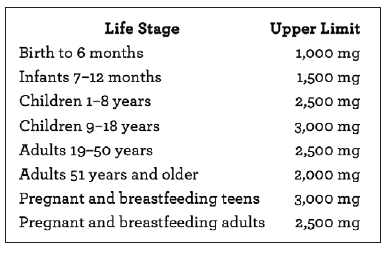Your body needs the mineral calcium to build and maintain strong bones, to move your muscles, and for your nerves to carry messages. Calcium also helps your blood vessels move blood and helps release hormones that affect many functions in your body.
Getting too little calcium can cause soft, weak bones in children and adults. But getting too much calcium isn’t good either.
What is calcium and what does it do?
Calcium is the most abundant mineral in the body. Almost all calcium in the body is stored in bones and teeth, giving them structure and hardness.
Your body needs calcium for muscles to move and for nerves to carry messages between your brain and every part of your body. Calcium also helps blood vessels move blood throughout your body and helps release hormones that affect many functions in your body.
How much calcium do you need?
The amount of calcium you need each day depends on your age and sex. Average daily recommended amounts are listed below in milligrams (mg).
What foods provide calcium?
Calcium is found in many foods. You can get recommended amounts of calcium by eating a variety of foods, including the following:
Milk, yogurt, and cheese are the main food sources of calcium for most people in the United States.
Canned sardines and salmon with bones contain calcium.
Certain vegetables, such as kale, broccoli, and Chinese cabbage (bok choi) also contain calcium.
Calcium is added to some beverages, including many fruit juices and milk substitutes such as soy and almond beverages, as well as some brands of tofu and ready-to-eat cereals. To find out whether these foods have calcium added, check the product labels.
Most grains (such as breads, pastas, and unfortified cereals) do not have high amounts of calcium. However, because people eat them often, what they contribute adds up.
What kinds of calcium dietary supplements are available?
Calcium is found in many multivitamin-mineral supplements, in calcium supplements, and in supplements that contain calcium and other nutrients such as vitamin D. Check the Supplement Facts label to determine the amount of calcium in the supplement.
The two main forms of calcium in dietary supplements are calcium carbonate and calcium citrate. Calcium carbonate is absorbed best when taken with food. Some over-the-counter antacids, such as Tums and Rolaids, also contain calcium carbonate.
Calcium citrate is well absorbed on an empty stomach or a full stomach. People with low levels of stomach acid—a condition most common in older people—absorb calcium citrate more easily than calcium carbonate.
Other forms of calcium in supplements and fortified foods include calcium sulfate, calcium ascorbate, calcium microcrystalline hydroxyapatite, calcium gluconate, calcium lactate, and calcium phosphate.
Calcium is absorbed best when you take 500 mg or less at one time. If you take 1,000 mg/day of calcium from supplements, for example, it is better to take a smaller dose twice a day than to take it all at once.
Calcium supplements might cause gas, bloating, and constipation in some people. If you have any of these symptoms, try spreading out the calcium dose throughout the day, taking the supplement with meals, or switching the form of calcium you take.
Calcium dietary supplements can interact or interfere with certain medicines, and some medicines can lower calcium levels in your body. Speak with your physician or health practitioner for more information.
Are you getting enough calcium?
Many people in the United States get less than recommended amounts of calcium from food and supplements, especially:
Children and teens aged 4 to 18 years
Non-Hispanic Blacks and non-Hispanic Asians
Adults aged 50 years and older living in poverty
Certain groups of people are more likely than others to have trouble getting enough calcium, including:
Postmenopausal women. The body absorbs and retains less calcium after menopause. Over time, this can lead to fragile bones.
People who don’t drink milk or eat other dairy products. Dairy products are rich sources of calcium, but people with lactose intolerance, people with milk allergies, and vegans (people who don’t consume any animal products) must find other sources of calcium. Options include lactose-free or reduced-lactose dairy products; canned fish with bones; certain vegetables, such as kale, broccoli, and Chinese cabbage; calcium-fortified fruit juices and milk substitutes such as soy and almond beverages, tofu, and ready-to-eat cereals; and dietary supplements that contain calcium.
What happens if you don’t get enough calcium?
Getting too little calcium can cause several conditions, including the following:
Osteoporosis, which causes weak, fragile bones and increases the risk of falling
Rickets, a disease in children that causes soft, weak bones
Osteomalacia, which causes soft bones in children and adults
Can calcium be harmful?
Some research suggests that high calcium intakes might increase the risk of heart disease and prostate cancer.
High levels of calcium in the blood and urine can cause poor muscle tone, poor kidney function, low phosphate levels, constipation, nausea, weight loss, extreme tiredness, frequent need to urinate, abnormal heart rhythms, and a high risk of death from heart disease. However, high levels of calcium in the blood and urine are usually caused by a health condition such as high levels of parathyroid hormone or cancer, not by high calcium intakes.
The daily upper limits for calcium include intakes froSource: https://ods.od.nih.gov/ factsheets/Calcium-Consumer/?utm_ medium=email&utm_source=govdeliverym all sources—food, beverages, and supplements—are listed below.
Source: https://ods.od.nih.gov/ factsheets/Calcium-Consumer/?utm_ medium=email&utm_source=govdelivery
Updated: November 17, 2021
Exclusive content from CARE Magazine













